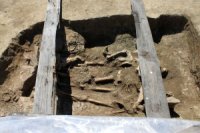 According to information from Russian Geographic Society, excavations of next kurgan began in Tuva, at the Eerbek-10 archeological site. The work is led by TIGI archeologist Nikolai Smirnov. A burial of Kok-el culture(i.e. Hunnic-Sarmatian era, approximately 2nd-6th century of Common Era, just before the Turkic period). The burial yielded human bones - a young woman or a young man, who was presumably covered with a skin of a horse ( horse skull and bones were found as indirect evidence). It is already obvious that the site was partially robbed. It is planned to finish the preliminary study of the finds several days, and to provide a more accurate date. According to information from Russian Geographic Society, excavations of next kurgan began in Tuva, at the Eerbek-10 archeological site. The work is led by TIGI archeologist Nikolai Smirnov. A burial of Kok-el culture(i.e. Hunnic-Sarmatian era, approximately 2nd-6th century of Common Era, just before the Turkic period). The burial yielded human bones - a young woman or a young man, who was presumably covered with a skin of a horse ( horse skull and bones were found as indirect evidence). It is already obvious that the site was partially robbed. It is planned to finish the preliminary study of the finds several days, and to provide a more accurate date.
Remember that the archeological expedition of RGO for study of the territories immediately in the zone of "Kyzyl-Kuragino" railway construction started on 11 June.
A video-bridge "Moscow-Valley of Tsars" took place on 30 June. President of RGO Sergei Shoigu connected with the students. One of TGU history department students, Saglana Kongaa showed several objects from the Kiev era (9th-5th century BCE). Among her finds was an elongated boulder with roughly carved oval representing a human face from the shore of Eerbek river. Saglana also found a stone grain hand mill. Another TGU student, Omak Saryglar showed off a bronze decoration of a horse harness of hemispherical shape with an opening drilled in the center. These objects were found in the materials of Ak-Dak 1 cemetery. Scientists suppose that all these objects were of ritual character, but, in their words, it will be possible to come to final conclusions only after the work on the kurgan is finished.
The kids also told us about their cheerful life at the camp. Every day, there is a cultural program after morning work and lunch: dances, yoga, bathing, singing with a guitar. There ar excursions to the capital of Tuva and to various Tuvan lakes.
A new shift of students from Moscow and Sankt-Peterburg arrived to Eerbek in early July.
|
